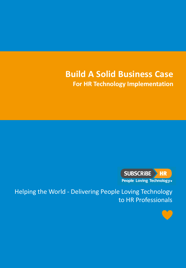If your organisation is still using manual processes, and / or outdated legacy systems to manage your HR tasks and processes, then you are definitely operating at a disadvantage. In addition to cost and time savings, Cloud based HR software offers multiple benefits, including a considerable reduction in the amount of stress that manual processes induce in your Employees, thus improving overall wellbeing. However, in order to get stakeholders, leadership and the finance team to approve your project, you will need to build a solid Business Case to demonstrate why the project is needed and what the benefits of the project will be when it is finished. Such reasons and benefits may seem perfectly obvious to you and your project team, but to stakeholders and other decision makers it may not be so clear cut. Therefore, a well prepared Business Case can really help you build a watertight argument for the implementation of HR technology. Outlined below are the four pillars upon which a robust Business Case should stand.
Step 1: The Status Quo
The first, and most important part of the process is for you to document the current Status Quo in your organisation. If you do not have a clear picture of where you have been (or where you are currently), how can you demonstrate where your proposed project is going to take you or the business? This applies to software implementation just as much as it does to business organisation or any other industry in which projects are executed. Documenting the Status Quo should involve a careful evaluation of your current business model, as well as mapping out the tasks and processes that are completed by the people who are directly impacted by the project. You might need to interview certain subject matter experts or follow a day in the life of your Employee/s in order to get an accurate record of how things actually work at your organisation 'as it is.' Most importantly, all your assumptions must be challenged and researched so that there are no surprises down the road when the project begins to transform the Status quo into something different, new and hopefully better.
Step 2: The Ideal (and Well Validated) Future Vision
Once you know where your organisation is at, and / or where you have been, then it is time to document the ideal future scenario that your project aims to create. This is your opportunity to really shine, as you present the potential rewards that your project implementation can offer the business. In the case of an HR technology project, this is your opportunity to deliver data on the gains you can make in productivity, the cost reduction your project will facilitate, as well as illustrating the potential for stress reduction if manual, paper based processes are phased out of the HR function. Whatever value and benefits your project is going to deliver to your organisation, they need to be documented, illustrated and verified just as carefully as the Status Quo was. Ensure that you can show the process you worked through to challenge and test all your assumptions, and make sure you have the data to back up your final recommendations. The final documentation of your ideal future vision then becomes the initial scoping statement for the project.
Step 3: The Transition From Status Quo To Your Ideal Future Vision
Now that you have a clear picture of both the Status Quo and your ideal (and well validated) future vision, it is time to document the steps that will take you from the beginning to the end of your project. This does not yet have to be a detailed project schedule or task list, but it should give a high level overview of how the project team is going to take your organisation from one point to the next. This overview should include the resources and time required to implement the project. This road map will show the decision makers and the stakeholders how they can help you get the project off the ground and make the idea a reality, as well as illustrating that you have done your homework and you're more than capable of delivering the goods.
Step 4: The Return on Investment
The last pillar of your Business Case requires that you show the return on investment. This is a crucial piece of the puzzle that will provide stakeholders, leadership and the finance team with the foundation they need to be able to make a fully informed decision about your project. Ultimately, you need to answer the question/s about how your project is going to enable your business to achieve its goals and fulfill on your strategic plan; and you need to do it in a way that is unequivocal and irresistible. If your organisation is willing to provide the time and resources for you to execute the project, you need to be able to give them a result that makes getting the green light a no brainer. If the return on investment can be quantified into dollars in the form of savings or returns, then that will be a great help in building your Business Case; it is difficult to argue with solid data and hard numbers. Of course, all assumptions about the return on investment will be scrutinised closely, so be sure to do your homework very carefully when gathering the data upon which to base your Business Case.
If you're an HR Professional in an SME and you're ready to step out from under a mountain of paperwork and manual processes, but you're not sure how to build a Business Case, we've created a White Paper that outlines a framework for you to follow. Just click on the button below to access your free Business Case Builder!



